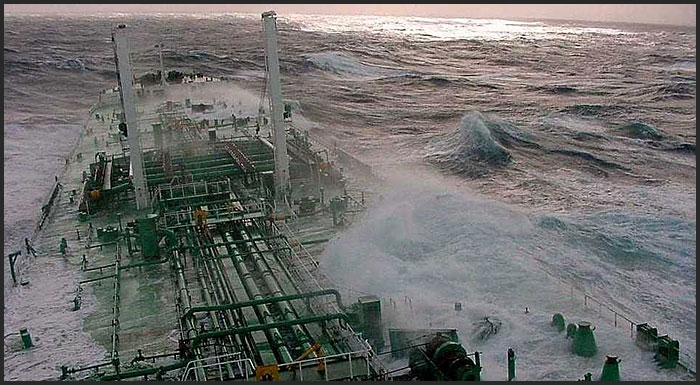You cannot really have a sea adventure without a storm story – and we have one. Many oceanographers spend many days at sea and never experience one. But just as weather fronts move across the landmass generating rain, storms, and sometimes tornados – they cross over the ocean as well, generating high winds and rough seas. It can be quite an experience.
Just as storms at home, you can go to bed at night to wake up to horrible weather the next day – like it came from nowhere. I remember we got word from the crew that “tomorrow may be a bad blow”. They did not seem terribly worried, but they were preparing. The sailors of old had other ways they knew when a “bad blow” was going to come. Red Sky at Night is a Sailor’s Delight… Red Sky in the Morning Sailor Should Take Warning is a classic. Mackerel Skies and Mares Tails Make Sailors Carry Small Sails is another. We have all experienced these old sayings, whether we knew them or not. The old guys had no national weather service reporting on radio or a radar picking heavy cloud cover and rain. They depended on these old lines to let them know a storm was brewing. I heard one recently from an Air Force pilot – as jets fly by… long contrails mean rain in 3 days; short ones mean good weather. How every you figured it out, the storm was coming, and preparation was needed.

Preparation in the since those things had to be battened down. The ship would roll in heavy seas and items would slide across tables, fall on the floor, flip upside down, if you did not secure them. Time to secure them. Nets in, instruments secured in racks, no loose items anywhere.
Like many nights on land when a storm is coming, I went to bed under a beautiful star filled sky. As the evening wore on, the “O 2” began to list more to starboard and port. The big ship as slowly rocking back and forth, and I remembered why some crew ran to her on the day we left port – being on the top bunk was harder in heavy seas. I did find a board to place across the open end of the bed so that I did not fall out.
When morning arrived, we were in heavy seas. The ship was rolling much more. I got up to go to the restroom and discovered that for gentlemen, it is much better to sit down to urinate than the traditional standing method. Standing did not go well. A shower was interesting too. Ship showers were already pretty small and tight. You had to learn to maneuver within to wash. But with a rocking ship, it became more interesting.

Photo: NOAA
We had developed “sea legs” by this time, but in this blow, it was still difficult to walk to breakfast. When a ship leaves port it experiences rolling seas more than flat calm. Even in a small rolling sea the ship slowly rolls one way and another. To walk around takes a few hours- sometimes days – to adjust to. You are trying to walk a straight line, but it is not happening. Eventually, you get your “sea legs” and have mastered when to step, and where, so that you are walking straighter. But in heavy seas, everyone still struggles. The tables in galleys have some method of securing your plate so that it does not slide off while eating. I just held my cup of coffee – though the cups are designed not to slide.
After breakfast I was going to do my traditional “visit the bow and see what’s there” – but the seas were too high and the waves were crashing and spraying, so I went to the stern. No nets were deployed but the arms that held the nets were in the down position. The crew were all sitting in white plastic chairs outside talking. It was not raining, and the wind was not even blowing that hard back there. They invited me to take a seat, and I did.
I held on to a handrail and stuck my foot under a fixed box to try from sliding. The skies were gray, as was the once cobalt blue water of the Gulf of Mexico. The waves rose and fell as I looked over the port side. They said seas were 5-10 feet. They were plenty big. As I looked out, I could see large gray waves rise with streams of white foam within. The “O 2” would list in the opposite direction as this happened, until the wave would fall back, and the “O 2” rolled the other way. As it would roll down the arm of the boom that held the nets would skim across the surface of the sea creating a trough. Then the process would repeat.
I talked with the crew about a lot of things, but they were most interested in changing careers. Most of them were interested in attending nursing school at the University of South Alabama and were asking me a lot of questions about it. I found this puzzling because so many people would love to have a life at sea (except maybe during a storm) – yet they wanted off. I asked why. They replied that people need to understand that they are on this ship an average of 300 days a year. Only 52 days on dry ground with their families. They missed Christmas, birthdays, a lot of things. Though they enjoyed what they were doing, after several years they were looking for a change. I guess I can see that. I remember taking Marine Tech Methods in college and our professor was explaining to us that as scientists you are visitors on research ships. For the crew this is their home. We needed to remember that and treatment them in this manner – you are a visitor.
As we talked about this and other things the ship rolled. The seas seemed to be getting larger and some of the crew thought the ship should take a different heading. Like all jobs, the workers were complaining about the boss’s decisions. But then the “O 2” made a deep list to port and the arm that held the net dug into the sea. It was like putting your foot down on the street while riding a bike. The ship made a sudden jerk, slowed, and turned slightly to port. Everyone was holding on while this was happening. I remember feeling the sensation of being thrown, even though I was still in my chair. Then I noticed the none of the four legs of the chair were still touching the deck. I had my hand on the rail the whole time but grabbed harder as the boat listed until my chair was back on deck. It happened very fast, and I did not fall out. One of the crew grabbed the phone to let the bridge know what had happened (I am sure they knew something happened) and the “O 2” made an adjustment. I decided it was time to go in. By the way… we all had our life jackets on while outside.
As Captain Ron said in the movie… “they come on ya fast – and they leave ya fast” – so it is with storms. Eventually this one blew out and we were once again in calmer seas and able to get back to work.
Tomorrow we were heading for port… the adventure was ending… Part 9.
Sea stories…
Seasickness… it is a real thing. As folks work to get their “sea legs” the motion of the ocean can cause nausea – sometimes severe. Your brain focuses on the rolling motion of the ship and you experience a rolling sensation in your mind. As you feel yourself rolling in one direction, your brain is preparing for the roll in the opposite. All of this can make you dizzy and nauseas. They say you begin to turn green. Nothing seems to help. You may eventually vomit and that gives some relief, but the ship is still rolling and your brain is focused on it. Often the problem is enhanced with the smell of fish or diesel and the nausea and headaches become worse. It is a horrible feeling, and you cannot get off the boat – in this case not for seven days.
It happened to two co-operators on this cruise. One was a student from the University of New Orleans. She was in charge of the plankton tows and just never adjusted to the rolling seas. She was sick the entire cruise. Another was a physical oceanographer from Minnesota. The same… he never got over it and actually never went anywhere without his life jacket on. He felt horrible. Note: I read that during the voyage of the HMS Beagle Charles Darwin was seasick much of the time.
But then there are others, like me, who did not have this feeling. Some old sailors will say “I never get seasick”. But as one of the crew on the R/V Verrill II from Dauphin Island Sea Lab told me – everyone has their day. Mine was at Dauphin Island. We were heading out to the Deep Blue for a day trip of sampling. As we left the dock the weather was not great but the captain had decided it was safe enough to do what we had planned to do. As we rounded the east end of Dauphin Island and headed to sea, the waves increased. The Verrill is not a big ship. It was a 65-foot boat. And as we headed into the waves it was soon discovered that it WAS too much. I remember heading past the Sand Island Lighthouse the waves began to climb higher. On one I remember the Verrill moving towards a vertical position, and I saw the captain’s eyes widen. He decided it was time to turn this around and head back. But the issue was now how to do this safely. The Verrill was a slow boat and would have to make a U-turn in high seas. The captain waited… waited… waited… and when we crested one wave he turned hard to port and gave it full throttle. The Verrill spun and roared as the next wave came. Then it hit me. I am not sure whether it was focusing on the rolling motion, the sudden smell of strong diesel, or what, but the famous “turning green nausea” was there. I did not vomit but it was not a good feeling.
How do people avoid seasickness. Many can walk around the ship and have no problems. Again, that was the only time I felt it. I can’t say for sure. They say that when you begin to feel it focus on something that is NOT moving – the horizon, a lighthouse, the clouds. I have told students this when I noticed them feeling bad (during my days as an instructor at Dauphin Island Sea Lab). For some this works. For others it does not. Some take medications before they leave port that helps. It makes them sleepy, but it seems to help. Maybe that is the trick – go to sleep.
Whatever the cause, seasickness can be part of being an oceanographer at sea.
 1
1
